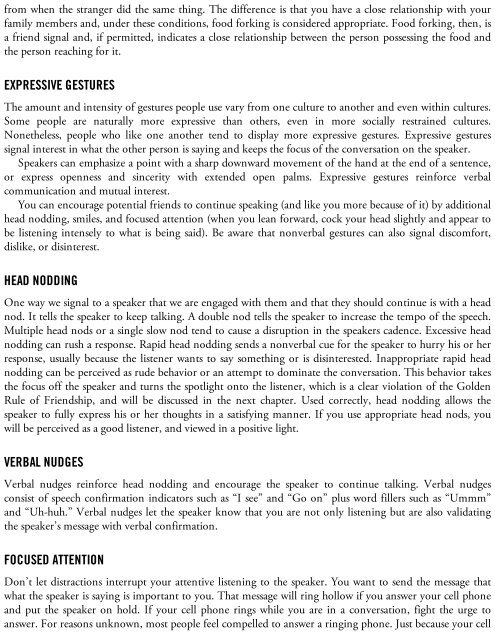[DR_The_Like_Switch
Create successful ePaper yourself
Turn your PDF publications into a flip-book with our unique Google optimized e-Paper software.
from when the stranger did the same thing. <strong>The</strong> difference is that you have a close relationship with your<br />
family members and, under these conditions, food forking is considered appropriate. Food forking, then, is<br />
a friend signal and, if permitted, indicates a close relationship between the person possessing the food and<br />
the person reaching for it.<br />
EXPRESSIVE GESTURES<br />
<strong>The</strong> amount and intensity of gestures people use vary from one culture to another and even within cultures.<br />
Some people are naturally more expressive than others, even in more socially restrained cultures.<br />
Nonetheless, people who like one another tend to display more expressive gestures. Expressive gestures<br />
signal interest in what the other person is saying and keeps the focus of the conversation on the speaker.<br />
Speakers can emphasize a point with a sharp downward movement of the hand at the end of a sentence,<br />
or express openness and sincerity with extended open palms. Expressive gestures reinforce verbal<br />
communication and mutual interest.<br />
You can encourage potential friends to continue speaking (and like you more because of it) by additional<br />
head nodding, smiles, and focused attention (when you lean forward, cock your head slightly and appear to<br />
be listening intensely to what is being said). Be aware that nonverbal gestures can also signal discomfort,<br />
dislike, or disinterest.<br />
HEAD NODDING<br />
One way we signal to a speaker that we are engaged with them and that they should continue is with a head<br />
nod. It tells the speaker to keep talking. A double nod tells the speaker to increase the tempo of the speech.<br />
Multiple head nods or a single slow nod tend to cause a disruption in the speakers cadence. Excessive head<br />
nodding can rush a response. Rapid head nodding sends a nonverbal cue for the speaker to hurry his or her<br />
response, usually because the listener wants to say something or is disinterested. Inappropriate rapid head<br />
nodding can be perceived as rude behavior or an attempt to dominate the conversation. This behavior takes<br />
the focus off the speaker and turns the spotlight onto the listener, which is a clear violation of the Golden<br />
Rule of Friendship, and will be discussed in the next chapter. Used correctly, head nodding allows the<br />
speaker to fully express his or her thoughts in a satisfying manner. If you use appropriate head nods, you<br />
will be perceived as a good listener, and viewed in a positive light.<br />
VERBAL NUDGES<br />
Verbal nudges reinforce head nodding and encourage the speaker to continue talking. Verbal nudges<br />
consist of speech confirmation indicators such as “I see” and “Go on” plus word fillers such as “Ummm”<br />
and “Uh-huh.” Verbal nudges let the speaker know that you are not only listening but are also validating<br />
the speaker’s message with verbal confirmation.<br />
FOCUSED ATTENTION<br />
Don’t let distractions interrupt your attentive listening to the speaker. You want to send the message that<br />
what the speaker is saying is important to you. That message will ring hollow if you answer your cell phone<br />
and put the speaker on hold. If your cell phone rings while you are in a conversation, fight the urge to<br />
answer. For reasons unknown, most people feel compelled to answer a ringing phone. Just because your cell


